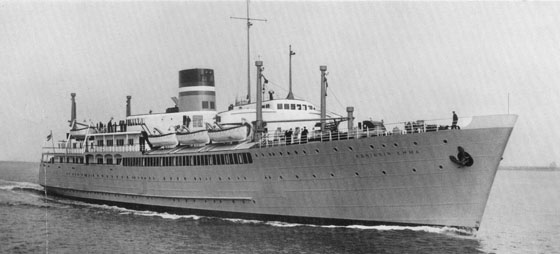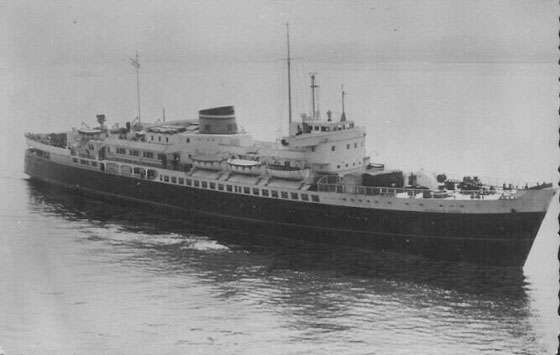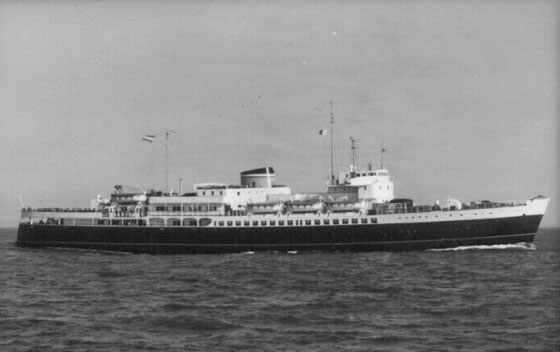
A period publicity shot of the M/S Koningin Emma, date unknown but presumably shortly after delivery.
Since 1875 the Stoomvaart Mij. Zeeland company had been providing shipping service between Vlissingen and several ports in eastern England using a modest fleet of ships suitable for this short crossing of the southern end of the North Sea.
During the late 1930's improving economic conditions allowed the Stoomvaart Mij. Zeeland company to place an order for two fast motor ships, the last additions to their fleet had been in 1920 & 1922. During 1938/1939 the Royal Schelde Shipyard in Vlissingen laid down the keels for the ships which would be known as the 'Koningin Emma' and 'Prinses Beatrix'.
These two new ships of 4,353 tons were each powered by two ten cylinder Schelde-Sulzer diesel engines delivering 12,500 hp and a speed of 22 knots. The ships had a capacity of 1,800 passengers and thirty five vehicles. However there intended use on the Vlissingen - Harwich ferry service was shortlived as World War Two thrust itself upon the daily routines of Western Europe. Following the occupation of Poland the regular services into Harwich were discontinued, attempts to replace this with a service to Tilbury were shortlived and the fleet, including the two new vessels was laid up.
During the week of May 10th 1940 the 'Koningen Emma' & the 'Prinses Beatrix' along with several other vessels escaped to England where they would be chartered out to the British Ministry of War Transport, with the two brand new motor-vessels converted at Belfast as the first Landing Ship Infantry (LSI) vessels, also known as 'attack transports' and renamed into 'Queen Emma' & 'Princess Beatrix'. It is reported that they carried a mixed English-Dutch crew because the British Navy was not familiar with their Sulzer diesel engines. Armament fitted to these vessels included 2 × 76.2mm, 2 × 40mm and 6 × 20mm guns. Large sets of davits had been installed to allow the lowering of eight landing craft.
Both ships were used between August 1940 & April 1946 for troop-transport and landing-operations in Dieppe, Sicily, Normandy and the Far East.
During January 1941 Operation Claymore was conceived as an amphibious operation on Vestfjord in the Lofoten Islands. Two months later on March 1st the plan became reality as a force sailed from Scapa Flow, refuelled in the Faroes and in the pre-dawn hours of March 4th entered Vestfjord. The task force included the Queen Emma, Princess Beatrix, six destroyers (mostly of the Tribal Class) as escort whilst two cruisers provided distant support and two Home Fleet battleships were 200 miles to the west.
Whilst sailing to the destination low clouds were present, protecting the task force from observation by German sccout planes. But on the morning of the 4th the weather was clear and cold with a calm sea. The Queen Emma landed No.4 Commando in two fishing villages, one being Svolvaer in the eastern part of the Lofotens, Princess Beatrix landed No.3 Commando twenty miles further west in two other fishing villages.The landing was virtually unopposed, the destruction of the fish oil facilities was achieved as was the sinking of the German factory ship SS Hamburg (6,132 tons) and several small enemy merchant ships. Shortly after midday the mission was complete, the Commandos withdrew without loss. One unexpected outcome was the meeting and capture of the armed whale Krebs by the destroyer HMS Somali. Although the Enigma code machine was quickly thrown overboard the boarding party captured vital documents which would assist the code breakers at Bletchley Park in naval signals decryption during April & May.
Operation Halberd saw both ships sailing from the United Kingdom on September 17th 1941 as part of a convoy to provide relief for Malta. The two ships however were detached at Gibralter on September 25th 1941.
On August 18th 1942 both ships sailed from the Portsmouth/Southampton area as part of the fleet involved in the failed raid at Dieppe, they were two of nine LSI's. On the return passage a minor collision took place between the Princess Beatrix and the small LSI Invicta.
The ships were in the western Mediterranean in the first week of November 1942 assisting in the movement of troops to Algiers and on to Bougie, Phillipville & Bone, the five ships in this group were nicknamed the 'The Moonlight Squadron'. Their route along the North African coast would be known as 'dive bomb alley', movements on this route being frequently greeted by Axis dive-bombers.
The Princess Beatrix was also involved in the landings at Anzio - it is reported that the handling of these ships in this landing was greatly appreciated by the troops going ashore. Following this action the LSI's left the Mediterranean to support the actions on D-Day.
Late in July 1944 Princess Beatrix sailed to take part in Operation Dragoon, the invasion of southern France between Toulon & Cannes by Allied troops.
During the early part of August 1944 the Queen Emma was noted on troopship movements between Yarmouth and the Cherbourg area. After the troops were disembarked the Channel was re-crossed to Portsmouth/Southampton area before moving on to Yarmouth to board more troops.
During July 1945 the two ships were in the Far East delivering a detachment of Marines headed for Penang. This trip was thwarted following the dropping of the atomic bombs on Hiroshima and Nagasaki. Following the capitulation of the Japanese the Princess Beatrix sailed as part of a force to the Netherlands East Indies to retake control of the former European colonies in the area. On August 23rd the Queen Emma & Princess Beatrix were anchored at Great Nicobar Isle along with forty four other vessels of varying sizes. Further offshore were twelve other ships including the battleship Nelson and cruisers Nigeria & Ceylon.
Following the end of hostilities in 1946 the two ships returned to Vlissingen and were handed over to the Dutch Government who then returned them to the original owners - the S.M. Zeeland. The ships moved to the Royal Schelde shipyard in Vlissingen to remove their wartime fittings and return them to a condition suitable for their service on the Harwich route. However the harbour at Vlissingen had sustained much damage from bombing, so 1948 the ferry services were inaugurated from Hook of Holland to Harwich.

For the next twenty years these two vessels would ply this route, however during 1960 a new vessel entered service, the 'Koningen Wilhemina', which had a larger capacity being able to handle sixty cars and had space for fourteen containers of mail and other cargo. Further changes occurred during 1965 when British Rail and the S.M. Zeeland looked to improve the Hook of Holland - Harwich services by emplying new ships that could make a round-trip in twenty four hours. Two new ships were ordered, the 'Koningen Juliana' and the 'St George', both entering service in the latter half of 1968. These new vessels were powered by engines from MAN or Pielstick.
With these two new vessels in service the 'Koningen Emma' and the 'Prinses Beatrix' were taken out of service and laid up, during December they were sold to Jos de Smedt in Antwerpen for scrapping.
Details of the M/S 'Koningen Emma' & 'Prinses Beatrix'
Built: Koninklijke Mij. "De Schelde", Vlissingen
Launched: 1939
Tonnage: 4,353 gross tons, 2,188 dwt
Length: 115.82 metres
Breadth: 14.38 metres
Draught: 4.40 metres
Propulsion: Two Sulzer 10 cylinder 12,500bhp, built under license
Screws: Two
Speed: 22/23 knots

Page added April 1st 2007.
Return to Ship menu
Return to site menu